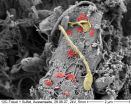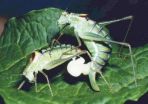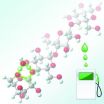(Press-News.org) Researchers at the University of Gothenburg, Sweden, and the Chalmers University of Technology, Sweden, demonstrate that an altered gut microbiota in humans is associated with symptomatic atherosclerosis and stroke. These findings are presented in a study published in Nature Communications on December 4.
The human body contains ten times more bacterial cells than human cells, most of which are found in the gut. These bacteria contain an enormous number of genes in addition to our host genome, and are collectively known as the gut metagenome.
How does the metagenome affect our health? This question is currently being addressed by researchers in the rapidly expanding field of metagenomic research. Several diseases have been linked to variations in the metagenome.
Researchers at Chalmers University of Technology and Sahlgrenska Academy, University of Gothenburg, now also show that changes in the gut metagenome can be linked to atherosclerosis and stroke.
The researchers compared a group of stroke patients with a group of healthy subjects and found major differences in their gut microbiota. In particular, they showed that genes required for the production of carotenoids were more frequently found in gut microbiota from healthy subjects. The healthy subjects also had significantly higher levels of a certain carotenoid in the blood than the stroke survivors.
Carotenoids are a type of antioxidant, and it has been claimed for many years that they protect against angina and stroke. Thus, the increased incidence of carotenoid-producing bacteria in the gut of healthy subjects may offer clues to explain how the gut metagenome affects disease states.
Carotenoids are marketed today as a dietary supplement. The market for them is huge, but clinical studies of their efficacy in protecting against angina and stroke have produced varying results.
Jens Nielsen, Professor of Systems Biology at Chalmers, says that it may be preferable to take probiotics instead – for example dietary supplements containing types of bacteria that produce carotenoids.
"Our results indicate that long-term exposure to carotenoids, through production by the bacteria in the digestive system, has important health benefits. These results should make it possible to develop new probiotics. We think that the bacterial species in the probiotics would establish themselves as a permanent culture in the gut and have a long-term effect".
"By examining the patient's bacterial microbiota, we should also be able to develop risk prognoses for cardiovascular disease", says Fredrik Bäckhed, Professor of Molecular Medicine at the University of Gothenburg. "It should be possible to provide completely new disease-prevention options".
The researchers have now started a company, Metabogen, to further develop their discoveries relating to the metagenome. Their success is based on close cooperation between engineers, microbiologists and doctors.
Jens Nielsen and Fredrik Bäckhed both agree that one of the challenges in the rapidly developing area of metagenomics is its multidisciplinary facets, requiring novel collaborations and merging of research fields.
###
The paper "Symptomatic atherosclerosis is associated with an altered gut metagenome" was published on December 4.
Contact:
Fredrik Bäckhed
Professor of Molecular Medicine at the Sahlgrenska Academy
University of Gothenburg
Jens Nielsen
Professor of Systems Biology at Chalmers University of Technology
46-70-243-66-18, nielsenj@chalmers.se
Fredrik Karlsson
Research Student
Systems Biology at Chalmers University of Technology
46-31-772-38-86, fredrik.karlsson@chalmers.se
The research was funded by:
Knut and Alice Wallenberg Foundation, the Chalmers Foundation, Swedish Heart Lung Foundation, Torsten Söderberg's Foundation, IngaBritt och Arne Lundbergs Foundation, AFA Insurances, the Swedish Research Council, and the Swedish Foundation for Strategic Research. END
PITTSBURGH, Dec. 13, 2012 – University of Pittsburgh Cancer Institute (UPCI) researchers have identified over 125 genetic components in a chemotherapy-resistant, brain tumor-derived cell line, which could offer new hope for drug treatment to destroy the cancer cells.
The results will be reported in the cover story of December's issue of the journal Molecular Cancer Research, to be published Dec. 18 and currently available online.
The potential drug targets were identified after testing more than 5,000 genes derived from glioblastoma multiforme, an aggressive brain ...
This press release is available in German.
Leipzig. Remains of dead bacteria have far greater meaning for soils than previously assumed. Around 40 per cent of the microbial biomass is converted to organic soil components, write researchers from the Helmholtz Centre for Environmental Research (UFZ), the Technische Universität Dresden (Technical University of Dresden) , the University of Stockholm, the Max-Planck-Institut für Entwicklungsbiologie (Max Planck Institute for Developmental Biology) and the Leibniz-Universität Hannover (Leibniz University Hannover) in the ...
This press release is available in German.
All a question of timing: When bushcrickets mate, the male attaches a sticky package, the so-called spermatophore, to the female's abdomen. Alongside the sperm themselves, this 'bridal present' consists of a protein-rich mass that the female eats after mating. It then takes several hours for the sperm to find their way into the female's reproductive tract. But, who decides when that will happen? A study by the Bielefeld biologists Professor Dr. Klaus Reinhold and Dr. Steven Ramm suggests that it is the male who determines the ...
Montréal, December 14, 2012 – Dr. Marie Kmita and her research team at the IRCM contributed to a multidisciplinary research project that identified the mechanism responsible for generating our fingers and toes, and revealed the importance of gene regulation in the transition of fins to limbs during evolution. Their scientific breakthrough is published today in the prestigious scientific journal Science.
By combining genetic studies with mathematical modeling, the scientists provided experimental evidence supporting a theoretical model for pattern formation known as the ...
New research from North Carolina State University provides molecular-level insights into how cellulose – the most common organic compound on Earth and the main structural component of plant cell walls – breaks down in wood to create "bio-oils" which can be refined into any number of useful products, including liquid transportation fuels to power a car or an airplane.
Using a supercomputer that can perform functions thousands of times faster than a standard desktop computer, NC State chemical and biomolecular engineer Dr. Phillip Westmoreland and doctoral student Vikram ...
Highlights
In a study of African Americans with kidney disease, levels of mineral metabolites rose over time; those with faster rates of kidney function decline had the greatest increases in metabolites.
Higher baseline levels of metabolites were linked with an increased risk for kidney failure or death independent of kidney function.
Disordered mineral metabolism is more severe in African Americans with chronic kidney disease, which might partially explain why their disease progresses more rapidly to kidney failure.
Washington, DC (December 13, 2012) — Abnormalities ...
Highlights
Blocking the receptor for endothelin lowers novel cardiovascular risk factors in patients with chronic kidney disease independent of blood pressure.
The findings suggest that blocking the receptor may provide heart-related benefits to these patients.
60 million people globally have chronic kidney disease.
Washington, DC (December 13, 2012) — Blocking the receptor for proteins that constrict blood vessels reduces markers of heart-related problems in patients with chronic kidney disease (CKD), according to a study appearing in an upcoming issue ...
A new study from the rainforests of Panama provides an unprecedented level of detail regarding the diversity and distribution of arthropod species from the soil to the forest canopy. Yves Basset, scientific coordinator of the CTFS Arthropod Initiative at the Smithsonian Tropical Research Institute, led an international team on Project IBISCA-Panama to sample, sort, catalogue, and finally estimate that a 6,000 hectare forest hosts a total of around 25,000 arthropod species – a figure vastly outnumbering that of better-studied organisms. The study will be published online ...
People over age 65 with high psychosocial distress face increased risk of stroke, according to new research in the American Heart Association journal Stroke.
Psychosocial distress is a broad concept that includes depression, stress, a negative outlook and dissatisfaction with life.
In their 10-year study, researchers followed 4,120 people in the Chicago Health and Aging Project for rates of death and stroke incidents. Due to some participants being involved in an HMO only 2,649 participants were analyzed for rates of incident stroke. Participants were 65 years and older ...
Washington, D.C. — When materials are stressed, they eventually change shape. Initially these changes are elastic, and reverse when the stress is relieved. When the material's strength is exceeded, the changes become permanent. This could result in the material breaking or shattering, but it could also re-shape the material, such as a hammer denting a piece of metal. Understanding this last group of changes is the focus of research from a team including Carnegie's Ho-kwang "Dave" Mao.
Their breakthrough research on the behavior nickel nanocrystals under intense pressure ...


